
MAY CONTAIN NUTS

Search Shorpy
SHORPY ART

Framed or unframed, desk size to sofa size, printed by us in Arizona and Alabama since 2007. Explore now.
Join and Share
Ad-Free Shorpy
Shorpy is funded by you. Patreon contributors get an ad-free experience.
Learn more.

Recent comments
- Baldwin 62303
- Baldwin VO-1000
- Cold
- No expense spared
- Tough Guys
- Lost in Toyland
- And without gloves
- If I were a blindfolded time traveler
- Smoke Consumer Also Cooks
- Oh that stove!
- Possibly still there?
- What?!?
- $100 Reward
- Freeze Frame
- Texas Flyer wanted
- Just a Year Too Soon
- WWII -- Replacing men with women at the railroad crossing.
- Yes, Icing
- You kids drive me nuts!
- NOT An Easy Job
- I wonder
- Just add window boxes
- Icing Platform?
- Indiana Harbor Belt abides
- Freezing haze
- Corrections (for those who care)
- C&NW at Nelson
- Fallen Flags
- A dangerous job made worse
- Water Stop
Member Photos
The Shorpy
Print Emporium
Print Emporium
Search Shorpy
Search results -- 30 results per page
- Beer Joint: 1905
- Detroit, Michigan, circa 1905. "Goebel Brewing Co., bottling works." Our third look at ... Posted by Dave - 05/16/2019 - 8:38am -
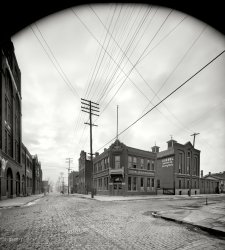
- Peerless Dental Parlors: 1905
- Detroit, Michigan, circa 1905. "Cincinnati, Hamilton and Dayton Railroad office, ... Posted by Dave - 08/08/2014 - 3:37pm -
![Peerless Dental Parlors: 1905 Detroit, Michigan, circa 1905. "Cincinnati, Hamilton and Dayton Railroad office, Woodward & Jefferson Aves." Last seen here, without the barefoot newsie. 8x10 inch dry plate glass negative, Detroit Publishing Company. View full size.
What do you supposeis the blurry, rectangular thing just above the manhole cover, behind the gent waiting for the streetcar? Is it rising, or falling?
[Abrasion on the negative. -tterrace]
How does that work?The Peerless Dentist upstairs advertises "teeth without plates" which was impossible in 1905 since dental implants hadn't been invented yet. Also, does anybody know what "vitalized air" was?
[Below from the Ohio State Journal of Dental Science, 1883. -tterrace]
Thank you tterrace for the enlightenment.
For Cash read CassiusCassius M. Havens was born in Allegany, New York in March 1845; in 1869 he married Adelaide Illick. They had 4 children: Beluach, Ninabelle, Grace and Hubert. Cassius was a sergeant in the Civil War in the 19th Regiment NY Volunteer Cavalry (later the 1st Reg NY Dragoons). Cassius died in 1907. I can't find a death date for Adelaide.
(The Gallery, Detroit Photos, DPC)](https://www.shorpy.com/files/images/SHORPY-4a20389a.thumbnail.jpg)
- The Firs: 1901
- Circa 1901. "The Firs -- New Baltimore, Michigan, from west." Our fourth look at this summer resort, where two ladies ... to be rolled right down.
Demolished in 2005 From Michigan.gov
The Firs, also known as the Hatheway House, located at 36240 ... Posted by Dave - 10/21/2014 - 10:16am -
![The Firs: 1901 Circa 1901. "The Firs -- New Baltimore, Michigan, from west." Our fourth look at this summer resort, where two ladies are setting out in the surrey with the fringe on top. 8x10 inch glass negative, Detroit Publishing Company. View full size.
Corbels and mortar scars and moreI wonder if the mortar scars are left from scaffolding. I've seen buildings where scaffolding was inserted as the walls were built; when it was removed there would be holes, which sometimes were just left and sometimes were filled in but still could be seen if you look closely.
The corbeling to support the brackets is very unusual, but nice. It makes you aware that they're supposed to be supporting a load.
I count three types of window tops: stone lintels on the far left, segmental arches in the wall facing us over the porch, and segmental arches with flat tops in the ell. The diamond panes look later than 1860, and there also seems to be a bit of window arch above the porch roof (it probably lit a stair landing), so I'm guessing that the wing was built later.
Prior to demolitionI have just found this document concerning delisting The Firs Historic District, New Baltimore. Page eight contains four pictures of the building prior to demolition in 2005.
A Fine, Sunny DayThe isinglass curtains won't need to be rolled right down.
Demolished in 2005From Michigan.gov
The Firs, also known as the Hatheway House, located at 36240 24 Mile Road in New Baltimore.
The Firs, originally called the Hatheway House, was a brick Italianate house constructed circa 1860 by Gilbert Hatheway.
Corbels and mortar scarsI'm not sure I've ever seen brick ledges like that, apparently made just for the corbels, but these certainly are nice enough corbels to deserve such treatment.
Does anyone know, or have a guess as to what those apparent mortar repairs would be from? There appear to be a pair at the top edge of each window, and a row along the porch wall.
Corbel treatmentI think the brick ledge is pure architectural design. I don't think I've seen that either but the widow's walk shows them as they usually occur. You'd think the standing water on the ledge would be hard on the wood.
SurreyThe wheels are yellow, the upholstery brown; the dashboard's genuine leather.
Other photosThis forum has some pictures of the house, apparently just before it was torn down in 2005.
But, what is this...?I'm with "Wiggy" on the scaffolding supports for sure. I have done major restorations on many houses in Norfolk dating back to the late 1800's and have seen these "fill-in repairs" quite often. However, i have not seen this style of brick supports for the corbels. They certainly work well structurally and look great... But, as "Paul A" pondered, the wood, would take a soaking bath unless the masons put a bevel of mud on the top edge out of sight, but anyway,... What is this crazy crooked patch?
This is a photo of the new addition to the building.Pictured standing is Abby K. Tillotson, proprietress of the house. In the buggy are her sister and mother.
The portion of the building in the foreground is the new addition that Abby had built to expand it into the resort called "The Firs". The original part of the building was build sometime prior to the civil war. Our best guess based on what we know is in the mid 1850's. This photo was taken July, 1901.
[There was no photo attached to your post. -tterrace]
(The Gallery, DPC, Horses)](https://www.shorpy.com/files/images/SHORPY-4a20390a.thumbnail.jpg)
- Candy Kitchen: 1908
- Grand Rapids, Michigan, circa 1908. "View of Monroe Street showing Hotel Pantlind." Not to ... Posted by Dave - 08/13/2013 - 4:09pm -
![Candy Kitchen: 1908 Grand Rapids, Michigan, circa 1908. "View of Monroe Street showing Hotel Pantlind." Not to mention the Candy Kitchen and Ice Cream Parlor. 8x10 inch dry plate glass negative, Detroit Publishing Company. View full size.
Handlesbar NetI like the net on the bike, and note correct usage: two handles, one bar.
[Kind of like teethbrush, or eyesglasses. - Dave]
Don't use the tower clock to sync your pocket watchThe clock on the tower says that it is 9:34, but the shadows, especially the awnings on the hotel, appear to be more middle of the day, noontime, shadows to me.
Amway Grand PlazaThe old Pantlind Hotel is now the east portion of the Amway Grand Plaza Hotel.
NowadaysIt would be called Kandy Kitchen.
Spacious Streetscape It's positively capacious! No bus shelters, benches, trees or overflowing litter receptacles. There aren't even any parking meters or lampposts to properly lock those newfangled bicycles against.
So many peopleBy my count there are over 40 people (and one dog) visible in the picture. That's more than in most cityscape pictures, even ones in much larger cities than Grand Rapids.
Cover StoryWhat's the story behind the tarps that are covering some of the store front windows?
(The Gallery, Bicycles, DPC, Streetcars)](https://www.shorpy.com/files/images/SHORPY_4a23403a.thumbnail.jpg)
- The Floating Tunnel: 1910
- ... Detroit River circa 1910. "Sinking last tubular section, Michigan Central R.R. tunnel. W.S. Kinnear, Chief Engineer, Butler Bros. ... Posted by Dave - 07/25/2012 - 4:10pm -
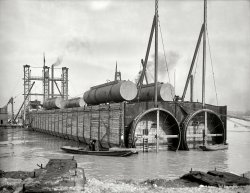
- Meanwhile, Back at the Stove Factory
- Chelsea, Michigan, circa 1901. "Glazier Stove Company, shipping room." Our sixth look ... Posted by Dave - 10/20/2012 - 10:50am -
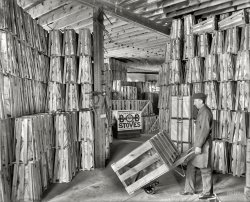
- D.R.T.: 1910
- Circa 1910. "Michigan Central R.R. -- Electric engine, Detroit River tunnel." 8x10 inch dry ... Posted by Dave - 09/17/2018 - 10:08am -
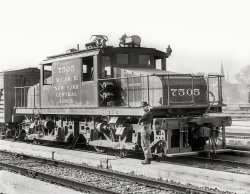
- Baraga School: 1905
- Marquette, Michigan, circa 1905. "Baraga School and St. Peter's Cathedral." 8x10 inch dry ... Posted by Dave - 09/03/2021 - 11:42am -
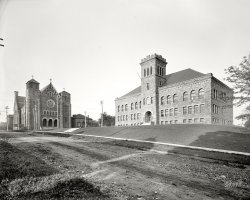
- Just Add Water: 1912
- November 8, 1912. Wyandotte, Michigan. "Steamer Seeandbee on the ways, broadside." The Great Lakes ... Posted by Dave - 03/09/2018 - 12:24pm -
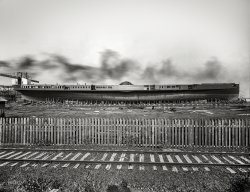
- Fellow Travelers: 1899
- ... to Buffalo and eventually Chicago (when you include their Michigan Southern subsidiary).
Today Garrison itself still has a rural feel ... Posted by Dave - 05/18/2016 - 12:43pm -
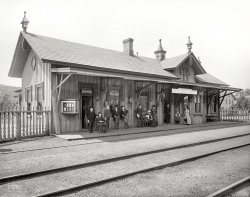
- Indian Curios: 1908
- Circa 1908. "Main Street, Mackinac Island, Michigan." No motor traffic allowed, but postcards and dentists galore. 8x10 ... Posted by Dave - 05/23/2019 - 10:05am -
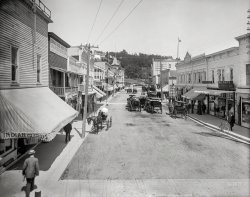
- Tunnel Vision: 1910
- Detroit circa 1910. "Michigan Central Railroad tunnel." Another view of the electrified tracks going ... Posted by Dave - 10/24/2012 - 10:40am -
![Tunnel Vision: 1910 Detroit circa 1910. "Michigan Central Railroad tunnel." Another view of the electrified tracks going under the Detroit River. View full size.
Mystery pipesDoes anyone know for sure what those vertical "pipes" were, that hang from either side of the bridge from the overhead cable? My guess would be that it is some sort of "low clearance" warning system to protect obstructions on the bridge from high trucks or trains.
[The obstructions don't need protecting. The telltales are there to protect you, if you're a brakeman, from the obstructions. -Dave]
Tell-TaleThe standard tell-tale design had ropes on 3" centers for a width of 8 feet over the track, the bottoms of the ropes 6" lower than the height of the obstruction and placed 100 feet before the obstruction. Today trains do not have walkways on top of the cars or means to get to the roof.
Dental WorkBrace yourself. Not only do we have the route canal going into the cavity under the river, but this image is crowned with bridge work going on a bit right of center. At least the debris and powder that was gumming up the tracks below the crest in a previous Shorpy post has been cleaned up. About the only thing missing are canines.
(The Gallery, Detroit Photos, DPC, Railroads)](https://www.shorpy.com/files/images/SHORPY_4a19899a.thumbnail.jpg)
- Ghost Ship: 1909
- ... "Launching party, freighter Benjamin Noble , Wyandotte, Michigan." 8x10 glass negative, Detroit Publishing Company. View full size. ... Posted by Dave - 04/15/2018 - 4:04pm -
![Ghost Ship: 1909 April 28, 1909. "Launching party, freighter Benjamin Noble, Wyandotte, Michigan." 8x10 glass negative, Detroit Publishing Company. View full size.
Top-heavy with a cargo of steel rails, the Benjamin Noble capsized in a squall 20 miles out from Duluth on April 14, 1914, vanishing into Lake Superior with the loss of all hands. After 90 years as a "ghost ship," its wreck was discovered at a depth of 400 feet off Knife Island in 2004, the front half buried in 40 feet of mud -- "heavily overloaded, just a submarine waiting to happen."
"Grease the skids"Here we see the origin of the term.
They were a Hardy Lot!Let's say the folks there average, oh, 165 pounds each. That's about 5,000 pounds of live-load on that rickety platform! And to have what looks like the "trigger" lines running below the reviewing stand? No chance of something snagging the flimsy framework of cobbled-together lumber and bracing — is there? A hardy, and trusting, lot indeed.
[If anything does go wrong, they'll be Hardy Buoys. - Dave]
Suppose anyone there's named Bob?
The Noble OliveThe young lady with the large bouquet who christened the vessel is Olive Noble, eldest daughter of the ship's namesake, president of Detroit's Capitol Brass Works and organizer of the Capitol Transportation Company that owned it.
(The Gallery, Boats & Bridges, Detroit Photos, DPC)](https://www.shorpy.com/files/images/SHORPY-4a16050a.thumbnail.jpg)
- Madison and State: 1907
- ... the background is Montgomery Ward headquarters at 6 North Michigan Avenue.
It's recently been converted to residential condos. ... Posted by Dave - 07/30/2012 - 10:09pm -
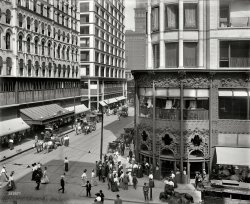
- The Great Locks: 1908
- ... at all times, induce a current of clear water from Lake Michigan into the drainage canal. The height of water in the canal is ... Chicago Sanitary and Ship Canal is on the route from Lake Michigan to the Mississippi River. If you want to circumnavigate the eastern ... Posted by Dave - 08/27/2014 - 12:14pm -
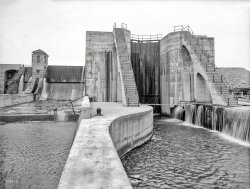
- Tucked In: 1905
- ... retired from service and used to store cement at Saginaw, Michigan. Sold for scrap in 2008, the E. M. Ford nevertheless remains intact ... Posted by Dave - 08/08/2012 - 7:11pm -
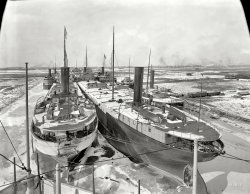
- A Horse's Tail: 1914
- April 27, 1914. Detroit, Michigan. "Stables, Gordon & Pagel Co. bakery." 8x10 inch dry plate glass ... Posted by Dave - 08/07/2012 - 3:00am -
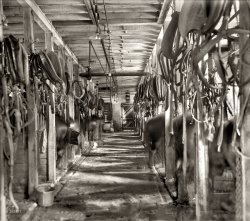
- Quincy Street: 1906
- Circa 1906. "Quincy Street -- Hancock, Michigan." In the copper country of the Upper Peninsula. Detroit Publishing ... it's First National Bank on the main floor, plus Northern Michigan Building & Loan Association on the second floor. They probably ... Posted by Dave - 02/06/2013 - 10:42am -
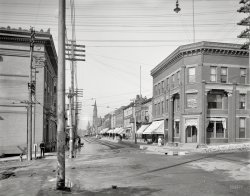
- Family Portrait: 1907
- ... around in my beloved Greenfield Village in Dearborn, Michigan, where we've restored two of 52 brick houses made and lived in by ... Posted by Dave - 07/22/2012 - 2:47pm -
![Family Portrait: 1907 Savannah, Georgia, circa 1907. "The whole black family at the Hermitage." 8x10 inch dry plate glass negative, Detroit Publishing Company. View full size.
The sign over the doorThe first word appears to be "Admittance." I cannot quite make out the second word.
[Actually you just did. NO ADMITTANCE EXCEPT BUS. - Dave]
Slave CabinsPerhaps these are still around in my beloved Greenfield Village in Dearborn, Michigan, where we've restored two of 52 brick houses made and lived in by enslaved workers at Henry McAlpin's coastal Georgia plantation, the Hermitage.
These houses are still standing on the plantationIt is private property, but as a teen we use to sneak onto the property and go in these houses. Kind of a test of manhood type thing. There are ghost stories abound about Hermitage Plantation and the slave houses.
(The Gallery, DPC, Savannah)](https://www.shorpy.com/files/images/SHORPY_4a18122a.thumbnail.jpg)
- Mirror, Mirror: 1942
- February 1942. "Detroit, Michigan. Negro girl putting up her hair." One in a series by Arthur Siegel ... Posted by Dave - 01/07/2013 - 10:46am -
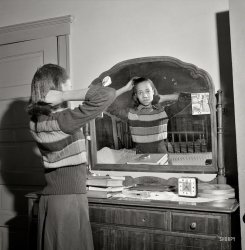
- Warship of the Air: 1942
- ... missions in September. Sincerely, Rick Wearing, Warren, Michigan.
(The Gallery, Andreas Feininger, Aviation, WW2) ... Posted by Dave - 11/23/2014 - 12:39pm -
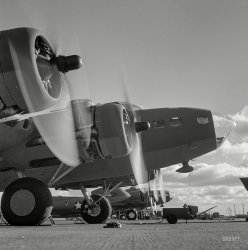
- Eastern Elevator: 1900
- ... to water's edge twenty-five miles southwest of Ludington, Michigan, on October 4, 1910; crew rescued by Maggie Marshall . Vessel bound ... Posted by Dave - 08/10/2012 - 12:21am -
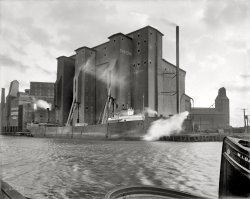
- Guys and Dolls: 1942
- Spring 1942. "Detroit, Michigan. Girls coming out of the Highland Park Chrysler plant." Photo by ... Posted by Dave - 01/03/2014 - 12:00pm -
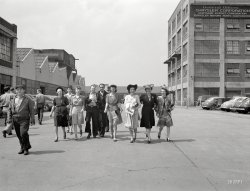
- Where the Girls Are: 1905
- ... beach, Lincoln Park." We return to the shores of Lake Michigan under the watchful gaze of Officer K. Kop. 8x10 inch dry plate glass ... Posted by Dave - 08/13/2012 - 9:13pm -
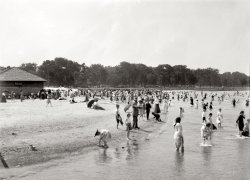
- Frank E. Kirby: 1910
- ... out of Detroit. Burned and scrapped in 1932 at Ecorse, Michigan.
(The Gallery, Boats & Bridges, DPC, Toledo) ... Posted by Dave - 08/09/2012 - 1:20pm -
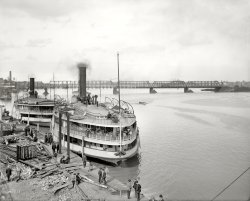
- Turnip Rock: 1900
- ... "The Thumbnail & Turnip Rock, Pointe aux Barques, Michigan." 8x10 glass negative, Detroit Publishing Company. View full size. ... Posted by Dave - 07/13/2015 - 11:14am -
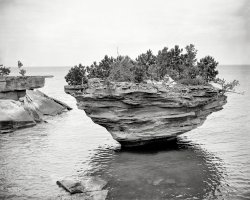
- The Big Dig: 1910
- ... removing rock loosened by dynamite, Livingstone Channel, Michigan." Construction of the navigation channel along the Detroit River circa ... Posted by Dave - 08/21/2012 - 5:57pm -
![The Big Dig: 1910 "Steam shovel removing rock loosened by dynamite, Livingstone Channel, Michigan." Construction of the navigation channel along the Detroit River circa 1910. 8x10 inch glass negative, Detroit Publishing Company. View full size.
More news herehttps://www.shorpy.com/node/10126
[Also some more old steam shovels here. - Dave]
What a shovelI never really thought about it but steam shovels like this one did not have a steam condenser,so the steam was ejected after each piston stroke through the pipe at the top of the rig. Consequently a steady supply of boiler feed water would have been necessary, and if the local water was hard cleaning the boiler tubes must have been a headache. Other than that there is an overhead tram for removing the excavated soil to a distant dump location.
Mike Mulligan and Mary AnneA few years later, Popperville would need a new town hall, and the rest is history.
Digging with steam?That looks like high pressure steam being released at the end of the boom. But then again, there is a long snaking hose running off to the right of the picture, Maybe they are using high pressure water to loosen rocks?
Marion Steam ShovelThe steam shovel appears to be a converted 'railroad-type,' built by the Marion Steam Shovel Co. of Marion, Ohio.
(The Gallery, DPC)](https://www.shorpy.com/files/images/SHORPY_4a18891a.thumbnail.jpg)
- A Banner Day: 1911
- ... the city by bus or streetcar. Then moved to Grand Rapids, Michigan, where you were extremely lucky if you could get within two miles of ... Posted by Dave - 01/23/2018 - 10:12pm -
![A Banner Day: 1911 Cleveland, Ohio, circa 1911. "Public Square -- Cuyahoga County Soldiers' and Sailors' Monument." With flags and bunting much in evidence. 8x10 inch dry plate glass negative, Detroit Publishing Company. View full size.
A Newfangled Auto? Who Needs One!I count at least 15 streetcars in one photo. Maybe I missed a couple.
StreetcarsThere are quite a few streetcars in this scene. I love the May Company building on the far right.
Accident?What's going on in front of the streetcar on the left side middle? It looks like a crowd of people gathering, and the wagon next to it seems to have dumped its load all over the street. Maybe someone got hit?
A newspaper feeding frenzy?I interpret the gathering around the wagon with half its load on the ground as a delivery of newspapers. The small crowd has gathered to buy the latest edition "hot off the press."
Those were the days of newsboys selling right on the streets!
The Shorpy Sleuths can tell us if it's a morning, afternoon, or evening edition by studying the shadow patterns.
[Whatever it is, it's not newspapers. - Dave]
Hometown PrideYep, the 1911 date is right there. Time of day via shadow length seemed like late afternoon but squared up by a view of the clock on the May Co. building in the upper right: 3:10 p.m. The bunting is for a D.A.R. reunion that summer.
Large stone building in the center was completed 1910 and is extant. The Soldiers' & Sailors' Monument (center right) was completed in 1894 and is also still standing, even after a recently finished redo of the whole of Public Square.
Here's a Shorpy photo from the opposite direction 11 years earlier: https://www.shorpy.com/node/17589
Keep up the good work ... yer feeding my habit !
15 StreetcarsAnd not a single one named Desire I'd bet.
Hey 19is my streetcar count. With that many, it would be no problem to get around! I lived in San Francisco for a while, and could get within three blocks of anywhere in the city by bus or streetcar. Then moved to Grand Rapids, Michigan, where you were extremely lucky if you could get within two miles of where you wanted to go. If Grand Rapids was anything like this scene, I'd have never needed a driver's license!
Wayward Implements"I am so tired of carrying this ladder. That's it, I quit."
A Small Bit Of Trivia...Down in the lower left hand corner of the picture would be where Ralphie and his family watch the Christmas Parade in the film, 'A Christmas Story". And also, the four squares that make up Public Square in this picture have been remodeled into two large ones; Ontario Avenue no longer goes all the way through the square.
CEICºThe Cleveland Electric Illuminating Co. had his offices in one of the buildings in the middle, at 75 Public Square.
Here's a square related to them:
(The Gallery, Cleveland, DPC, Patriotic, Streetcars)](https://www.shorpy.com/files/images/SHORPY-4a25315a.thumbnail.jpg)
- Fountain House: 1899
- Macomb County, Michigan, circa 1899. "Fountain House, Mount Clemens." Bath houses and mineral ... Posted by Dave - 08/15/2012 - 4:36pm -
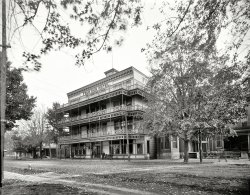
- Postal Kingdom: 1905
- Circa 1905. "Post office, Saginaw, Michigan." Perhaps our most Disneyesque P.O. so far. 8x10 inch glass negative, ... Posted by Dave - 07/19/2012 - 10:24pm -
![Postal Kingdom: 1905 Circa 1905. "Post office, Saginaw, Michigan." Perhaps our most Disneyesque P.O. so far. 8x10 inch glass negative, Detroit Publishing Company. View full size.
Workers' ParadiseI probably wouldn't have retired if I'd been working in that one. Not sure they would have gone for my spending my time making dioramas, though.
Memorial FlagCan anyone make out the sign?
["Navy Recruiting Station Permanently Located" - tterrace]
Thank You Saginaw!I was there a few years ago for a wedding but don't recall seeing the old post office. Here's a picture of it still going strong however!
Castle MuseumThe post office left the building long ago. It is now known as the Castle Museum and is the home of the Saginaw Historical Society.
AwningsI love the canvas awnings.
FinialsThere is much to admire about this old building. But, my favorites are the metal finials at the high points of the building. They are probably forged from copper.
Visited TodayWe visited the building today thanks to Shorpy. It is just as interesting on the inside as the outside. The tall tower has an incredible sprial staircase running up the outside wall. The main lobby is excellent too. Up in the attic space is a long narrow runway with peep holes to the floor spaces below so that inspectors could keep watch on the employees as they worked behind the counters and in the sorting rooms! A major addition in 1930 on the back of the building doubled it's size and was done so well you can't tell where the original building leaves off and the addition starts. The museum is excellent and the staff are very friendly. Highly recommended if you are ever in the area!
(The Gallery, DPC)](https://www.shorpy.com/files/images/SHORPY_4a22443a.thumbnail.jpg)























